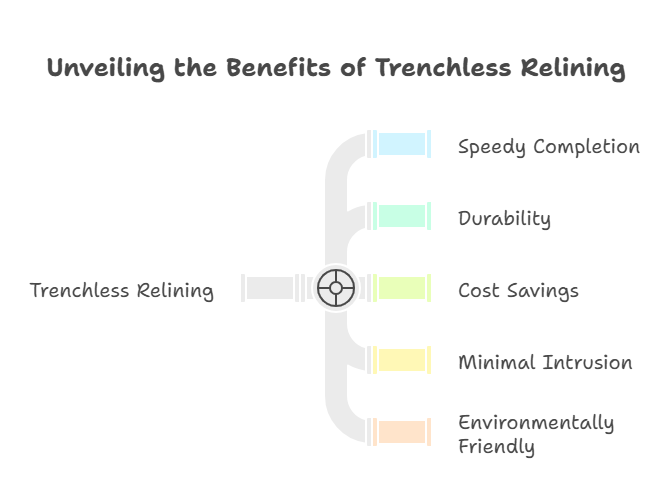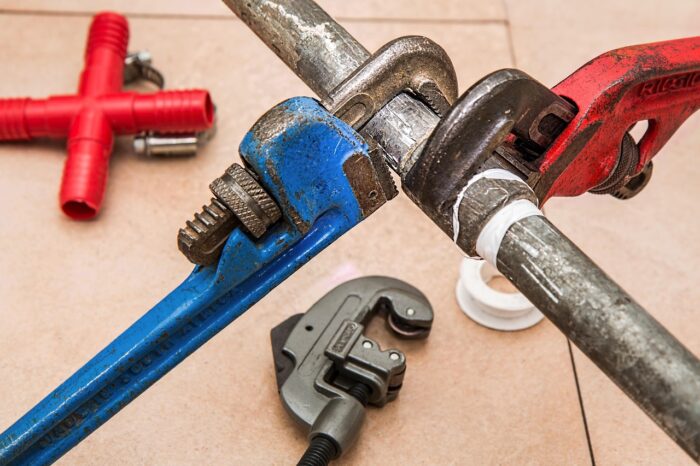Seamless Pipe Repair
Seamless Pipe Repair: Unlocking the Benefits of Trenchless Relining
If you are thinking of revamping your plumbing without digging up your yard you should look into the benefits of trenchless relining. Typically in a matter of a few hours your old pipe is replaced with a newer and stronger one making pipe lining a popular choice.
From preserving your yard to cutting down on repair time the benefits of trenchless relining are hard to ignore. So let’s dive into the world of how trenchless relining works.
Benefits of Trenchless Relining
Most homeowners are often surprised at the minimal disruption trenchless pipe repair actually causes. Some of the pipe lining benefits are as follows:
- Speedy completion: Most jobs wrap up in hours or a few days, not weeks.
- Durability to last decades: Expect a lifespan of 50 years or more from your relined pipe.
- Cost savings: Cheaper than full excavation and restoration costs.
- Minimal intrusion: No dug up yards or driveways, no trenching. Just a couple of access points, and you’re done.
- Environmentally friendly: Reduced waste, less energy use and minimal impact on soil and groundwater

How Trenchless Pipe Relining Works
Let’s discuss how trenchless pipe relining actually works so you know what to expect when you get a pipe lining near you.
- Initial assessment: To evaluate the existing condition of the pipe a sewer camera inspection is carried out. After a clear assessment of the pipe damage, the plumber is then able to make a customised pipe repair plan.
- Cleaning: Hydro-jetting is used where high pressure water clears debris, roots and buildup.
- Liner Insertion: A resin-infused tube is inserted via pull‑in‑place or inversion method. The flexible liner can bend in the pre existing pipes, allowing for the perfect solution for older pipe line systems.
- Curing: Liner hardens with heat, steam, or UV to become a seamless new pipe. After curation the liner essentially becomes a brand-new pipe within the old one, without any joints that can leak or collect debris over time.
- Final Checks: Another camera inspection verifies success, and lateral connections are restored. Plumbers double-check to make sure the new pipe is fully functional, leak-proof, and has optimal water flow.
Understanding pipe lining benefits and process
- Faster than traditional repiping – The entire pipe lining process from start to finish is non-intrusive and efficient. More often than not you are able to have a newly functioning pipe line within a week’s time since weeks of excavation are avoided.
- Cost-effective – Eliminates restoration of landscaping or driveways. Cracked drain pipe repair cost varies based on severity, but trenchless methods consistently save money by avoiding costly yard or concrete restoration.
- Stronger flow – The smooth, joint less interior resists buildup and damage. Over time, older pipes develop scaling, which reduces water flow. A new epoxy lining gives you a clean, smooth surface, helping wastewater exit your home efficiently and with fewer backups.
Lifespan of Trenchless Pipe Lining
Trenchless pipe lining isn’t just a quick fix, it’s built to last. Most epoxy-lined pipes have a lifespan of 50 years or more, thanks to their durable, corrosion-resistant material. The smooth interior also helps prevent future clogs and buildup, meaning fewer blockages and maintenance issues over time. It’s a long-term solution that truly holds up.
When comparing the cost of replacing drainage pipes through excavation versus trenchless methods, the long-term benefits truly outweigh the initial investment. Your home’s sewer system becomes more efficient, more durable, and less prone to emergency repairs in the future.
Conclusion:
To wrap it up, trenchless relining just makes sense — it’s faster, cleaner, stronger, and far more cost-effective than tearing up your yard or floors. But here’s the thing: the results are only as good as the team you trust to do the job. We at Ontario Pipe Lining aren’t just another contractor; we’re the go-to crew homeowners across the province call when they want sewer repair, drain repair and trenchless pipe lining done right.
We bring years of expertise, top-tier equipment, and a no-shortcuts approach that means your property stays intact, your pipes run smoothly, and your peace of mind stays for decades. Compared to the headache and high costs of replacing a drain pipe under a slab, our trenchless method is a smarter investment, one that saves you money now and spares you future repairs.
In short? Sewer repair doesn’t have to be a disaster. With us, it’s quick, precise, and worry-free, exactly how it should be.
Frequently Asked Questions
1. What are the disadvantages of trenchless pipe lining?
While trenchless pipe lining comes with a lot of benefits, it’s not a perfect fit for every job. A few drawbacks to keep in mind are higher upfront cost, a slight diameter reduction as the liner takes up a bit of space and while there’s no big trench, small entry holes may still be needed.
2. How long does trenchless pipe lining last?
Typically 50 years or more, thanks to strong epoxy and resistant materials.This lifespan rivals or even surpasses traditional pipe replacements, making it a long-term solution that pays off.
3. Why is pipe lining so expensive?
The costs are a reflection of the high-end materials, equipment and tedious installation. However, if you compare the cost with excavation and replacing pipe plus restoration on top of it definitely comes out higher. That said, the cost of replacing drainage pipes through trenchless methods is often offset by what you don’t spend on damage repair or landscaping.
4. Is trenchless pipe lining worth it?
Yes, since it avoids major digging, is time saving and protects your property. This method’s durable solution is investment worthy. The Benefits of Trenchless Relining make it a smart and worthwhile choice. Especially when considering the cost to replace drain pipe under slab or handle a cracked drain pipe repair cost, trenchless methods offer peace of mind, less mess, and more value per dollar.


